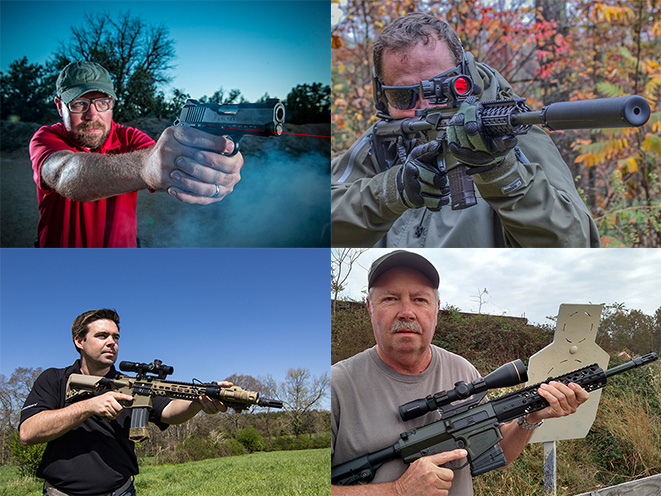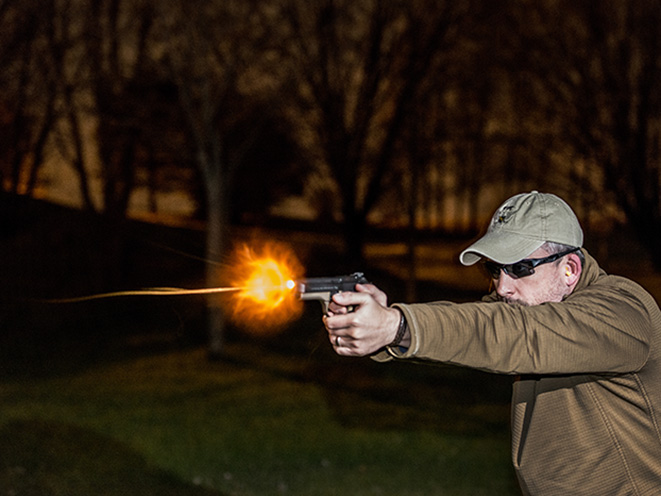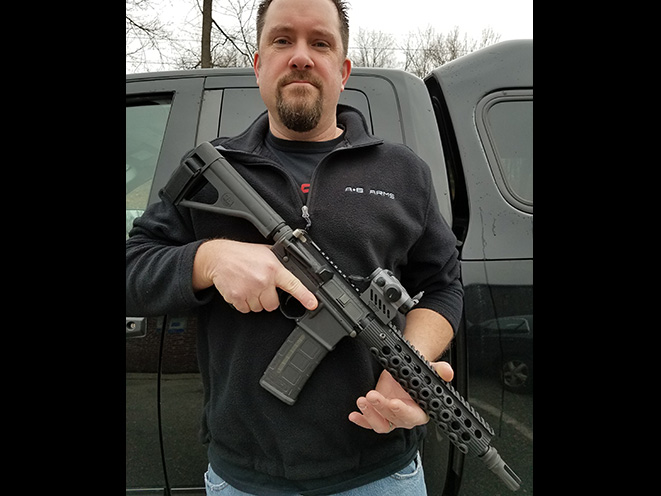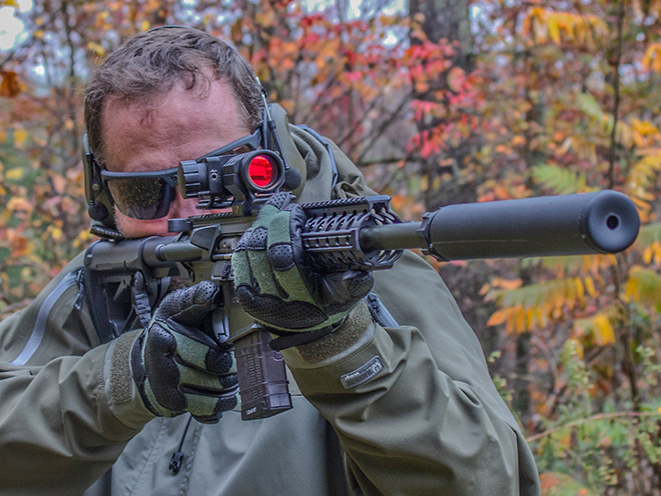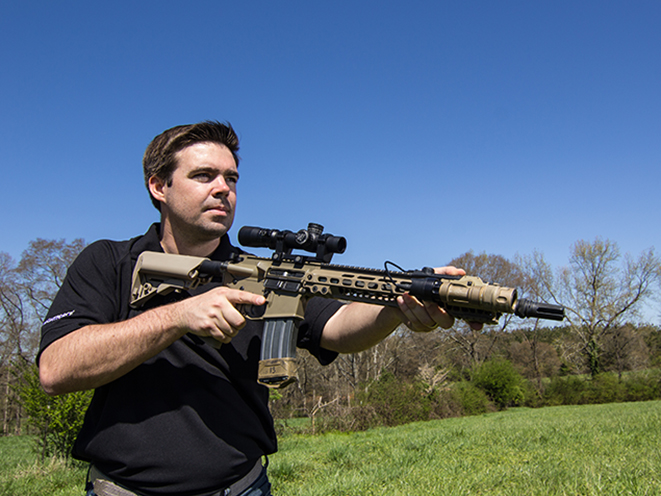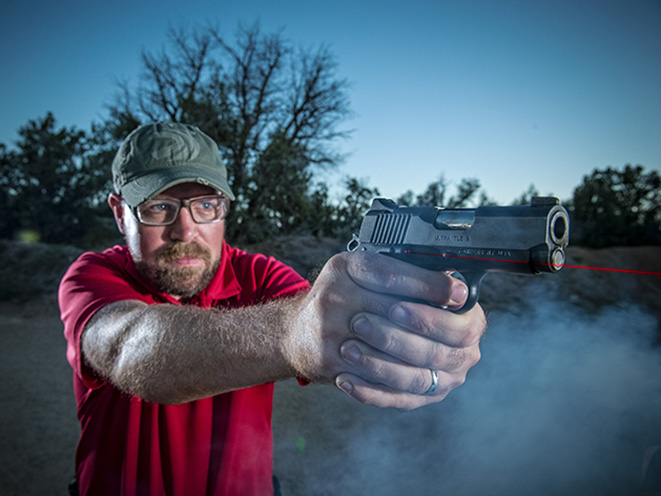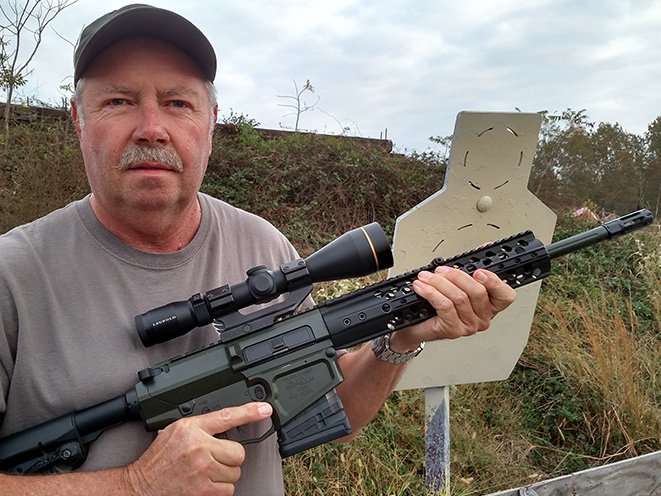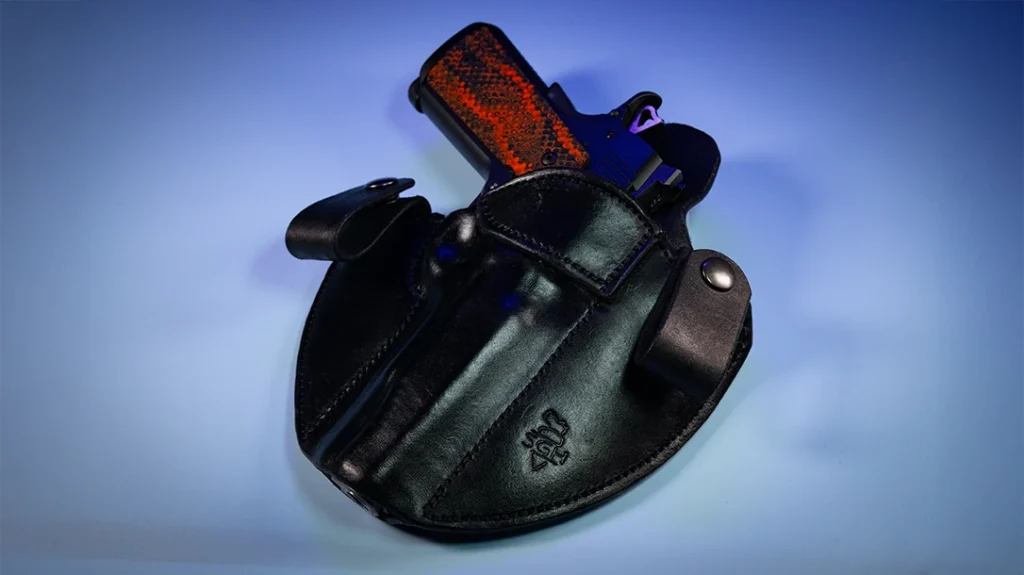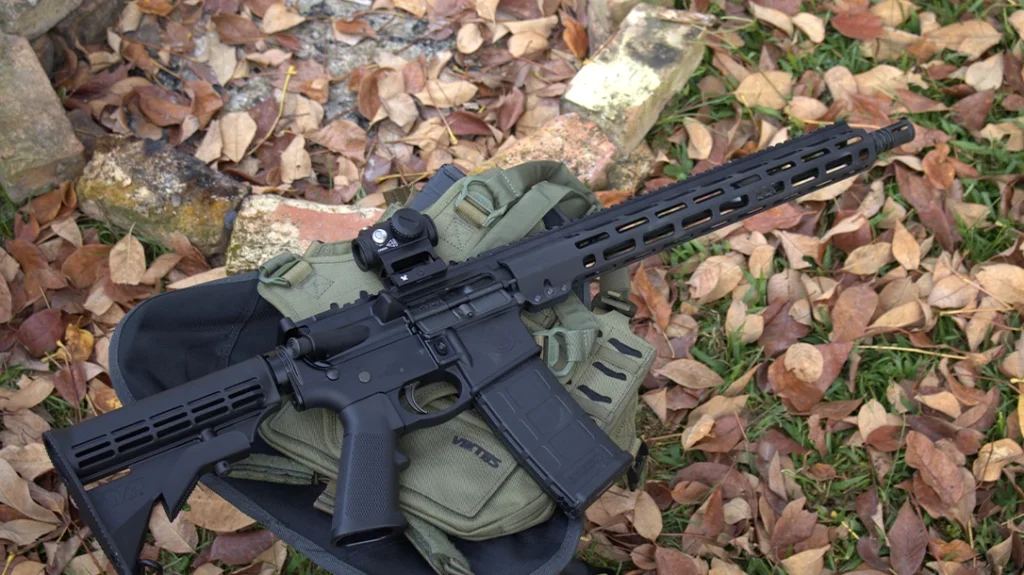Compiled by Jay Pinsky
Bart Bauer
- Affiliation: United States Navy Combat Camera
- Position: Retired chief petty officer, small-arms instructor, range master
- Home Defense Gun: 9mm handgun with mounted light
A 9mm handgun with a mounted light is my weapon of choice for home defense. Not because it’s compact, not because of its high-capacity magazine, but because it’s what I’ve trained on, over and over again, for many years. It’s what I know forwards and backwards.
Advertisement — Continue Reading Below
A 12-gauge pump shotgun or an AR is a good choice, too. They have their place, function and will handle home-defense scenarios quite well. But in my opinion, what weapons works best boils down to the shooter’s training and knowledge. The best weapon in the world does you no good if you don’t know how to operate it properly in a less-than-ideal situation.
Jason Combs
- Affiliation: American Built Arms Company
- Position: President and founder
- Home Defense Gun: AR pistol
The best weapon for home defense might be a hybrid between the AR and the handgun. I can only speak from experience, as my go-to weapon for home defense is a 300 Blackout AR pistol. Why? My home is a multi-level colonial with a fairly predictable architectural layout. Although I have multiple types of weapons in the house on each floor, I choose the 300 Blackout AR pistol because, within the confines of my home, the subsonic ammunition keeps my hearing intact. It also has greater knockdown power than your conventional .45 ACP +P round. The attached light and red-dot sight definitely add additional advantages if a night break-in occurs. Using a shorter 9.5-inch barrel on the AR-platform pistol gives me a definite tight-quarters advantage around the home’s sharp corners. Having a 30-round magazine doesn’t hurt, either.
Advertisement — Continue Reading Below
Danielle Dean
- Affiliation: Abduction Awareness Initiative
- Position: Founder and president, certified self-defense instructor
- Home Defense Gun: Glock 42, .45 Glock, 12-gauge shotgun, .38 revolver
Well, that is a loaded question, and a lot of variables play into the answer. Currently, my top favorites are the Glock 42 and a shotgun. However, I do have a .38 and a Glock .45 ACP for home defense as well. So, we will start with the weapons and then move on to the possible scenarios.
In the event of a home invasion, handguns are easy to draw, generally lightweight and make it easier to move around from room to room without any trouble.
Advertisement — Continue Reading Below
The Glock 42 in .380 ACP is lightweight, easy to manipulate and will probably stop the threat, providing the user can shoot in the general direction of the bad guy. Know your weapon and your ammo. Otherwise, this is a versatile little gun, I use it as my concealed-carry gun, too.
The .45 is a great gun, but for a woman, it can be a little heavy and cumbersome. That being said, my .45-caliber Glock has never jammed to date and would be intimidating to an intruder.
My snub-nose revolver in .38 Special is easy to handle. It’s a little clunkier than the .380 but never jams. I have fired all different types of rounds through it, and it works beautifully. My children can effectively fire the .38 Special without hesitation. The damage from the handguns is relatively the same if the ammunition type and grains are similar. Hollow points, high-grain ammunition or subsonic ammo will all drastically change the results downrange.
Advertisement — Continue Reading Below
Now comes the 12-gauge shotgun. If the scenario that presents itself allows for time, I would use the shotgun, hands down. The shotgun, if used within its effective range, will do massive damage, and the homeowner does not have to be very accurate with buckshot. A shotgun is also very intimidating, and even if the homeowner is experiencing high anxiety and shaking, the chances that he or she will stop the threat are high.
So, the short answer: Any of these weapons can cause catastrophic damage. You can stop an intruder with a .22 just as effectively as you can a shotgun or large-caliber handgun. What you use is not nearly as impactful as how you use it. Shot placement under duress, knowing what’s beyond your target (bullets pass through many surfaces, including bodies), shooting in dark/low-light areas and using cover effectively all affect the answer. You must know your weapon, know your rounds, know your limitations and know your abilities.
Cork Graham
Advertisement — Continue Reading Below
- Affiliation: Discovery Channel’s Treasure Quest
- Position: Team leader, photojournalist, hunter and author
- Home Defense Gun: Pistol (S&W 1911, Glock 17, Glock 21 Gen4, Bersa BP9CC)
Grab that pistol for home defense, and then work your way up from there. Shotguns, M16s and pistols kept me alive in combat in the Cold War during the second half of the 1980s in a variety of environments—jungles, swamps, mountains and urban situations. Each weapon was suited for the different situations, and I’ve used them all within urban settings. If I were to choose one for home defense, it would be a pistol, of which I try to keep within easy access an S&W 1911, a Glock 17, a Glock 21 Gen4 and a Bersa BP9CC, to name a few.
A pistol is my first line of defense, just because I can more easily have them located in strategically optimum locations within the home, much more easily than a larger rifle or shotgun. From there, if the need arose, I would then fight my way with that pistol to something with much more firepower, such as a Mossberg 500 or Benelli M4, with a seven- to eight-round magazine, or an AK-47 or AR-15 and a full chest rig of magazines.
- RELATED STORY: 9 Ways to Protect Your Family During a Home Invasion
My reasoning for a pistol as the initial go-to is maneuverability in an enclosed area, especially with a laser targeting system, such as Crimson Trace unit. Being able to accurately aim a pistol without having to sight down the barrel can be a major asset in certain conditions, such as when you want to keep to your cover but need to deliver fire quickly.
Advertisement — Continue Reading Below
Many laud the capabilities of a shotgun for home defense, especially starting with the sound of a pump shotgun as a tool of intimidation. These same folks will also say it’s the safest to use in conditions where stray bullets will go through drywall, but birdshot won’t. My reasoning to not use birdshot is that threats more easily get up from such a blast to the chest than they do from a 00 or 000 buckshot hit, especially if they’re wearing heavy clothing or armor. This goes back to the principle of using deadly force against an appropriate threat, and if so, making damned sure that deadly threat is removed.
As with any type of shooting, I’m also going to be very sure of where my projectiles will travel. As anyone who has looked at ballistics will tell you, whether it’s a .223, 7.62mm, 9mm, .45 or even a .22 LR, the round will travel through at least four walls in a modern-frame home, or eight sheets of drywall. Whatever you’re shooting, know where that projectile will travel.
Richard Mann
Advertisement — Continue Reading Below
- About: Richard Mann has contributed to every major firearms periodical and has written several books on firearms and tactics.
- Home Defense Gun: Depends on multiple factors
There’s a fallacy that in all things there must always be a “best.” But “best,” at best, is a conditional thing. On any given day, and in any given conditions, what’s best might be different. Asking the question of whether a carbine, shotgun or handgun is best for home defense—even in general terms—is like asking which fly is best for trout fishing. It is and will always depend.
It depends on a lot of things. It depends on which one you’re most comfortable with. For example, those not comfortable with an AR, and who are unwilling to learn the platform, should avoid it. It also depends on where your home is. An appropriate firearm for a ranch might not be ideal in an apartment complex. Another consideration is whom you share your home with. Ideally, with juvenile exceptions, everyone in your home should be capable of wielding the weapon.
From a lethality standpoint, you could argue between a carbine and a shotgun all day long. At reasonable home-defense distances, there’s really no argument to be had; both will get the job done. On the other hand, the handgun is far less effective at stopping a threat. However, it is infinitely more portable, easier to secure when not in use and just as intimidating to a felon when they are looking down the business end.
Advertisement — Continue Reading Below
At the same time, if you are serious about personal protection, you probably carry a handgun every day. If so, it’s perfectly logical for that firearm to protect you while you’re in your home. If you do not think it’s suitable for home defense, then it’s probably not suitable for everyday carry, either.
Don’t worry so much about which one is “best.” Choose the one you are the most competent with and the one that dovetails with your situation. In the end, your survival will depend more on you having the proper mindset, the tactics you apply and your marksmanship skills.
Sean Murphy
- Affiliation: Nightforce Optics
- Position: Marketing communications manager
- Home Defense Gun: AR-15 carbine
My choice for when something goes bump in the night is an AR-15 carbine. While shotguns and handguns are better than nothing, when evaluating the important aspects of a home-defense firearm, the AR stands supreme.
From a pure shooting aspect, it is easy to see that a 5.56mm AR is the easiest platform to shoot well, especially under speed and stress. Such a carbine offers a lightweight and handy platform that is easy to operate with light recoil and a generous capacity. With a scattergun, a shooter will fight increased recoil and a much lower capacity. Handguns provide convenience in a smaller package, but they are harder to shoot well and generally have a lower capacity compared to a carbine. I would also like to note that in a practical size comparison, carbines and short-barreled shotguns are similar in length compared to a handgun presented with the arms extended while maneuvering.
Aside from the technical merits, an AR carbine provides a modular platform that can be configured to create a home-defense system. Adding a white light can aid in target identification and provide a distraction for an opponent. A reliable red-dot sight enhances a shooter’s ability to deliver accurate rounds on target in all conditions while also being more forgiving of a shooter with a target focus—something one is sure to have if confronting an individual. The benefit of a sling is often overlooked, as you’ll generally not be rolling out of bed equipped for war, but the sling will give you a way to handle your carbine should you need to free up your hands for other tasks. Suppressors are a nice option where legal to minimize hearing damage when shooting indoors. While each platform can accept these various options, the AR carbine is still the best option due to the plethora of mounting options and ease of use.
Finally, let’s review ballistics. Shotguns can deliver an impressive payload at closer distances, but at the cost of recoil and reduced capacity. Handguns come in last as pistol cartridges have limitations in effectiveness. There is no doubt to the ballistic superiority of rifle cartridges, especially when loaded with modern projectiles. Even with a shorter carbine barrel, a 5.56mm/.223 will deliver much more energy on target. With easy follow-up shots and a generous capacity, the carbine is a force multiplier against even multiple adversaries. With an increasing trend of criminals utilizing body armor when committing their misdeeds, rifle cartridges provide a much better antidote to this problem as well.
In summary, all the qualities of ARs show why they are as prevalent as they are for duty and civilian defensive use. They are lightweight, easy to operate, easy to customize and ballistically effective while holding a lot of ammunition, creating the best platform for helping a person solve a home-defense problem.
Lance Padgett
- Affiliation: Gorilla Ammunition
- Position: Co-founder and CEO
- Home Defense Gun: Handgun
ν The debate over the best home-defense weapon has raged for years with everyone citing the pros and cons. I could argue the effectiveness of any of the aforementioned weapons with some degree of confidence, but new developments in ammunition make old arguments moot. Hence, it is not merely which firearm is the best for home defense, but it is what firearm and ammunition combination is the best for home defense. It should be viewed as a system approach.
Here is the way I see it today. Get rid of the shotgun. Yes, I know, you supposedly will not miss the intruder, but you might just hit a whole lot of unintended targets as well. I have seen plenty of buckshot penetrate drywall.
If you take out the shotgun, it’s down to the modern sporting rifle versus the handgun. Both of these firearms can be formidable home-defense weapons. Before I tell you my pick, I have to disclose that we are huge fans of MSRs here at Gorilla. We started in the industry loading 300 Blackout rounds before we ever thought about handgun ammo. We continue to load and shoot way more 300 Blackouts than anything else, so I am a little biased.
That being said, both handguns and MSRs can be outfitted with proper sights and lights to make them effective tools at day or night. Both hold plenty of ammunition, though hopefully you won’t have to engage in a prolonged firefight within the walls of your home. Both can also be loaded with limited-penetration ammunition that will reduce collateral damage due to errant shot placement.
I believe the winner, though, is the handgun. My decision is based on the effective range inside your home being very limited. The advantage of the handgun is size. A handgun is easier to lock up safely near your bed, keeping it out of the hands of children. It is easier to maneuver in tight spaces. A handgun is easier to control with one hand if necessary. As stated before, either a handgun or MSR can be loaded with limited-
penetration ammunition to keep from shooting through your intruder. We even have ammunition engineered to deliver devastating effects upon impact with human tissue yet fragment upon impact with drywall.
It goes without saying that to be effective in any situation, it is imperative that the shooter is comfortable and well trained with the firearm of choice. Given proper training and the proper ammunition, the handgun is a very effective home-defense weapon, even if a suppressed 300 Blackout AR loaded with Gorilla ammo is a lot more fun to shoot!
Linda Powell
- Affiliation: O.F. Mossberg & Sons
- Position: Director of media relations
- Home Defense Gun: Shotgun
A shotgun would always be my first choice, and more specifically, a 20-gauge youth or adjustable pump action with a shorter
cylinder-bore barrel. Having trained with ARs, handguns and shotguns for personal and home defense at Gunsite with a wide range of shooters (varied experience levels, gender and size), the pump-action shotgun’s reliability and ease of operation, and the availability of shotshell options, make it the ideal choice.
In a home scenario, you may have several individuals using the same firearm. The choice of a youth or adjustable-stock option, like Mossberg’s FLEX System, allows the shotgun to be handled comfortably by Mom, Dad or the kids. It is much easier to accommodate for a shorter stock than trying to shoot a shotgun that is too long for you to shoulder and cycle comfortably. For close-quarters situations, the shorter, lighter-weight barrel provides better balance and maneuverability. And the ability to shoot buckshot or lighter field loads, like birdshot or even turkey loads, provides less recoil and tighter pattern options. Add the reliability and ease of operation of a pump-action shotgun and you have the most versatile option for home defense.
From personal experience, my father, who is soon to be 91 years old, recently told me that he could no longer rack his handgun slide and had difficulty with his break-action shotgun, so he wondered what he should purchase for home defense. I set him up with a 20-gauge Mossberg 500 with target loads. He can manipulate the gun and handle the recoil.
JJ Reich
- Affiliation: Federal Premium Ammunition
- Position: Communications manager
- Home Defense Gun: Handgun
The firearm I have at the ready in a quick-access safe on my nightstand is a handgun. I store it right next to a tactical flashlight. These are my weapons of choice for in-home protection.
For me, it is easier and more convenient to keep a handgun stored safely and responsibly in my bedroom. Besides that, I am trained to use it. Training is an extremely important factor in my decision. I have taken a few classes on handgun use for personal protection and how to fight when pairing a pistol with a flashlight. Due to this training, I am more comfortable with a handgun for personal protection than I am with a rifle or shotgun. Don’t get me wrong: I am quite functional with a rifle and shotgun for hunting purposes. I just haven’t taken a tactical home-protection course with either platform yet. Once I do, I might change my strategy and select an AR-15 or tactical shotgun instead.
Bill Wilson
- Affiliation: Wilson Combat
- Position: President and founder
- Home Defense Gun: Pistol-Caliber Carbine
ν My choice of weapon for home defense is an easy one since I made it several years ago, and I have only upgraded its hardware over the years. My choice is a pistol-caliber carbine (PCC) in 9mm. Outfitted with an Aimpoint ACO, a Streamlight TLR-1HL weapon light and loaded with 20-plus rounds of subsonic 147-grain JHP ammo, the PCC is a great option for me.
Years ago, I started with a Marlin Camp Carbine modified to accept a weapon light and from there I progressed to a Colt 9mm carbine, then the excellent and super-reliable Beretta Cx4 Storm. But in 2016, when we developed our AR9 series of PCCs, I switched to an AR9B, the variant that accepts Beretta 92 magazines. Therefore, my bedroom armament now consists of an AR9B carbine loaded with 21 rounds, two spare Beretta 92 20-round magazines, a Beretta 92G Brigadier Tactical pistol (also loaded with 21 rounds) with a TLR-1 mounted and whatever pistol that was my daily-carry gun when I went to bed. Last night that was an X-TAC Elite Carry Comp 9mm with a TLR-6 light mounted. Why a 9mm PCC instead of an AR in 5.56mm, a shotgun or a handgun? Here are my reasons.
It’s quiet. Subsonic 9mm rounds fired from a 16-inch carbine barrel have a muzzle blast similar to a .22 Magnum or a suppressed 5.56mm carbine. Shooting a 5.56mm inside the confines of a building is not something I personally want to do if it can be avoided.
It’s easy to shoot. I’m not aware of any weapon other than a Ruger 10/22 with a red-dot sight that’s easier to shoot than a 9mm PCC. I can teach a complete beginner how to defend his or her home with this weapon in less than an hour. Compared to a handgun, it’s no contest!
It’s effective. After cleanly killing several feral hogs with my 9mm home-defense load, I have total confidence in its ability to stop a predator of the two-legged variety as well.
Another reason: large ammunition capacity. Depending upon which feeding device is chosen, it’s easy to find a PCC with a 20-plus capacity and sometimes as much as 34 rounds. Compared to a shotgun, this is a substantial advantage in firepower.
PCCs also offer more than enough range. Even inside the largest and most elaborate homes, a 20-yard shot in a home-defense scenario would be a long one, and defending one’s perimeter would rarely require a shot beyond 50 yards. Therefore, a 9mm PCC has plenty of effective range for the task at hand. There isn’t any comparison between a PCC and a handgun or shotgun in this regard.
